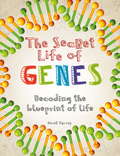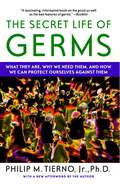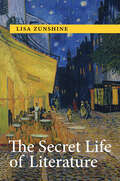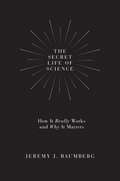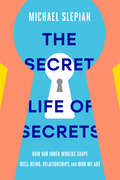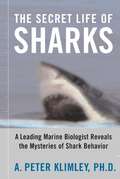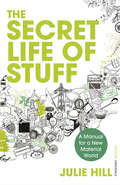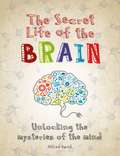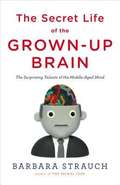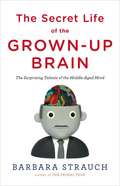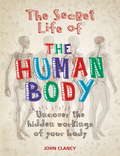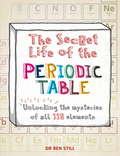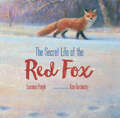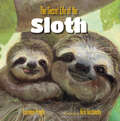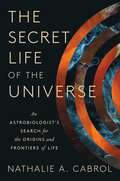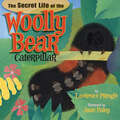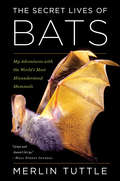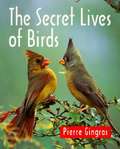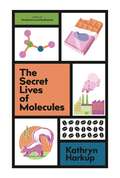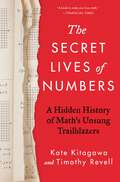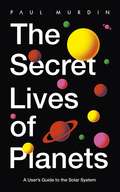- Table View
- List View
The Secret Life of Genes: Decoding The Blueprint Of Life
by Derek HarveyGenes have a huge impact on who we are, from defining us as humans, to governing how we behave. Whether controlling our cells or creating new forms of life, discover how DNA makes each of us unique.In The Secret Life of Genes, you'll learn all about the past, present and future of the human genome. Filled with colourful, graphic illustrations to help you to understand the world of genetics, from the basics to the most complex theories, this book brings the inner workings of the human body to life. Derek Harvey answers the biggest questions, from the nature of inheritance, evolution and reproduction, to how genes are arranged and how DNA is read.Take a trip through the history of the world's DNA and unlock the future of the field.
The Secret Life of Germs: Observations and Lessons from a Microbe Hunter
by Philip M. Tierno Jr.They're everywhere. Silent and invisible to the naked eye, they're on everything we touch, eat, breathe -- on every single inch of our skin. And despite the remarkable advances of science, germs are challenging medicine in ways that were unimaginable just a decade ago. Due to an explosion of infections never before reported in modern history and a new germ horror story surfacing every week, it's no small wonder that we're frightened -- and that antibacterial soaps are a billion-dollar business. Now, renowned microbiologist Philip Tierno cuts through the media hype with the compulsively readable Secret Life Of Germs, revealing exactly where the greatest threats may be hiding. The Secret Life Of Germs provides an inside view of this fascinating and elegantly ordered microscopic world -- from the common cold, E. coli, and Lyme disease to encephalitis, mad cow disease, and anthrax. It takes readers on a historical survey of the culprits of disease and explores the effect that they -- and the scientists who study them -- have had on our world. Rising above the common scare-tactic techniques used by many authors, Dr. Tierno's message is an optimistic one. Recognizing that humans are more often than not the main spreaders of disease, he offers numerous protective response strategies -- health and hygiene tips for inside and outside the home, advice on food safety, and pointers on human contact -- to stop the transmittal. Filled with practical and enlightening information, The Secret Life Of Germs is an engaging book that will keep readers mesmerized while helping them stay healthy.
The Secret Life of Literature
by Lisa ZunshineAn innovative account that brings together cognitive science, ethnography, and literary history to examine patterns of &“mindreading&” in a wide range of literary works.For over four thousand years, writers have been experimenting with what cognitive scientists call &“mindreading&”: constantly devising new social contexts for making their audiences imagine complex mental states of characters and narrators. In The Secret Life of Literature, Lisa Zunshine uncovers these mindreading patterns, which have, until now, remained invisible to both readers and critics, in works ranging from The Epic of Gilgamesh to Invisible Man. Bringing together cognitive science, ethnography, and literary studies, this engaging book transforms our understanding of literary history. Central to Zunshine&’s argument is the exploration of mental states &“embedded&” within each other, as, for instance, when Ellison&’s Invisible Man is aware of how his white Communist Party comrades pretend not to understand what he means, when they want to reassert their position of power. Paying special attention to how race, class, and gender inform literary embedments, Zunshine contrasts this dynamic with real-life patterns studied by cognitive and social psychologists. She also considers community-specific mindreading values and looks at the rise and migration of embedment patterns across genres and national literary traditions, noting particularly the use of deception, eavesdropping, and shame as plot devices. Finally, she investigates mindreading in children&’s literature. Stories for children geared toward different stages of development, she shows, provide cultural scaffolding for initiating young readers into a long-term engagement with the secret life of literature.
The Secret Life of Science: How It Really Works and Why It Matters
by Jeremy BaumbergA revealing and provocative look at the current state of global scienceWe take the advance of science as given. But how does science really work? Is it truly as healthy as we tend to think? How does the system itself shape what scientists do? The Secret Life of Science takes a clear-eyed and provocative look at the current state of global science, shedding light on a cutthroat and tightly tensioned enterprise that even scientists themselves often don't fully understand.The Secret Life of Science is a dispatch from the front lines of modern science. It paints a startling picture of a complex scientific ecosystem that has become the most competitive free-market environment on the planet. It reveals how big this ecosystem really is, what motivates its participants, and who reaps the rewards. Are there too few scientists in the world or too many? Are some fields expanding at the expense of others? What science is shared or published, and who determines what the public gets to hear about? What is the future of science? Answering these and other questions, this controversial book explains why globalization is not necessarily good for science, nor is the continued growth in the number of scientists. It portrays a scientific community engaged in a race for limited resources that determines whether careers are lost or won, whose research visions become the mainstream, and whose vested interests end up in control.The Secret Life of Science explains why this hypercompetitive environment is stifling the diversity of research and the resiliency of science itself, and why new ideas are needed to ensure that the scientific enterprise remains healthy and vibrant.
The Secret Life of Secrets: How Our Inner Worlds Shape Well-Being, Relationships, and Who We Are
by Michael Slepian&“If you&’ve ever wondered why we keep secrets and what motivates us to spill them, look no further. Michael Slepian has spent the past decade studying the psychology of secrets, and is ready to reveal his findings to the world.&”—Adam Grant, #1 New York Times bestselling author of Think Again Think of a secret that you&’re keeping from others. It shouldn&’t take long; behavioral scientist Michael Slepian finds that, on average, we are keeping as many as thirteen secrets at any given time. His research involving more than 50,000 participants from around the world shows that the most common secrets include lies we&’ve told, ambitions, addictions, mental health challenges, hidden relationships, and financial struggles.Our secrets can weigh heavily upon us. Yet the burden of secrecy, Slepian argues, rarely stems from the work it takes to keep a secret hidden. Rather, the weight of our secrets comes from carrying them alone, without the support of others. Whether we are motivated to protect our reputation, a relationship, a loved one&’s feelings, or some personal or professional goal, one thing is clear: Holding back some part of our inner world is often lonely and isolating. But it doesn&’t have to be.Filled with fresh insight into one of the most universal—yet least understood—aspects of human behavior, The Secret Life of Secrets sheds a fascinating new light on questions like: At what age do children develop the cognitive capacity for secrecy? Do all secrets come with the same mental load? How can we reconcile our secrets with our human desires to relate, connect, and be known? When should we confess our secrets? Who makes for the ideal confidant? And can keeping certain types of secrets actually enhance our well-being?Drawing on over a decade of original research, Slepian reveals the surprising ways that secrets pervade our lives, and offers science-based strategies that make them easier to live with. The result is a rare window into the inner workings of our minds, our relationships, and our sense of who we are.
The Secret Life of Sharks: A Leading Marine Biologist Reveals the Mysteries o
by A. Peter KlimleyMarine biologist Pete Klimley swims with the sharks. He was one of the first scientists to free-dive among sharks, and he has spent nearly thirty years studying shark behavior, sometimes swimming in schools of several hundred sharks. From his firsthand observations he has learned that sharks are not the vicious man-eaters that we imagine, but fascinating animals with complex behaviors.Most people who think of sharks at all think immediately of great white sharks. But there are more than four hundred species of shark. Dr. Klimley has studied several species, most notably the great white and the hammerhead. (He describes the great white as the athlete among sharks, and the hammerhead as the Ph.D. of the shark world.) In The Secret Life of Sharks Dr. Klimley reveals the significant discoveries he made about hammerhead navigation and great white eating habits. By studying hammerheads gathered around underwater seamounts, Dr. Klimley learned that hammerheads rely on sophisticated tracking of ocean-floor magnetism to navigate. His long-term study of great white sharks off the California coast demonstrated that these huge sharks prefer to eat seals and sea lions because of the energy contained in their fatty bodies. They are selective eaters, not the man-eaters we expect, and they sometimes go weeks between meals. But Dr. Klimley did observe a ritualized behavior that great whites practice in order to avoid deadly disputes over prey that one shark has captured and another wants.Although we have learned a great deal about shark behavior, says Dr. Klimley, there is much that we do not know. Unfortunately we are destroying these magnificent creatures of the deep through overfishing and degradation of the oceans. Already some populations of sharks have declined steeply.Vividly written by one of the foremost authorities on sharks, The Secret Life of Sharks is a fascinating account of some of the world's most magnificent animals.
The Secret Life of Stuff: A Manual for a New Material World
by Julie HillWouldn't you like: - Products that don't damage the environment?- A better way of life without agonising about your 'footprint'?- To really know your stuff?Climate change? Biofuels? Nuclear power? Landfills? Recycling? Renewable energy? Environmental issues can feel overwhelming. But, in fact, it is simple; it all comes down to one thing - stuff. Our use of the Earth's resources - whether a crisp packet or a cargo ship, a T-shirt or a wind turbine - has an inescapable impact on our future. In The Secret Life of Stuff, Julie Hill uncovers the origins and the true cost of what we use. Her inventory of over-consumption may shock but it is the first step towards overcoming waste. The misuse of stuff is not your fault, it's a product of history. But it is only by understanding what has gone wrong, that everyone - politicians, business people and us as consumers - can create a new and better material world.
The Secret Life of the Brain (Secret Life Of Ser.)
by Alfred DavidIn the long history of the study of anatomy, neuroscience is a relatively new field, and there are plenty of mysteries yet to be uncovered. The Secret Life of the Brain explores the fascinating advances that have been made in the field so far, from the intricacies of memory and intelligence, to the enigmatic workings behind our sense of humour and our dreams. Full of illuminating illustrations and diagrams, this book lifts the lid on how drugs affect the brain; the science behind addiction; how the brain deals with trauma and pain; and the effects on the brain of love, age, and sex. Finally, you'll get a tantalising insight into the cutting-edge theories that are attempting to get behind the elements of neuroscience which we still can't quite explain.
The Secret Life of the Brain (Secret Life of)
by Alfred DavidIn the long history of the study of anatomy, neuroscience is a relatively new field, and there are plenty of mysteries yet to be uncovered. The Secret Life of the Brain explores the fascinating advances that have been made in the field so far, from the intricacies of memory and intelligence, to the enigmatic workings behind our sense of humour and our dreams. Full of illuminating illustrations and diagrams, this book lifts the lid on how drugs affect the brain; the science behind addiction; how the brain deals with trauma and pain; and the effects on the brain of love, age, and sex. Finally, you'll get a tantalising insight into the cutting-edge theories that are attempting to get behind the elements of neuroscience which we still can't quite explain.
The Secret Life of the Grown-up Brain
by Barbara StrauchA leading science writer examines how the brain's capacity reaches its peak in middle age For many years, scientists thought that the human brain simply decayed over time and its dying cells led to memory slips, fuzzy logic, negative thinking, and even depression. But new research from neuroscientists and psychologists suggests that, in fact, the brain reorganizes, improves in important functions, and even helps us adopt a more optimistic outlook in middle age. Growth of white matter and brain connectors allow us to recognize patterns faster, make better judgments, and find unique solutions to problems. Scientists call these traits cognitive expertise and they reach their highest levels in middle age. In her impeccably researched book, science writer Barbara Strauch explores the latest findings that demonstrate, through the use of technology such as brain scans, that the middle-aged brain is more flexible and more capable than previously thought. For the first time, long-term studies show that our view of middle age has been misleading and incomplete. By detailing exactly the normal, healthy brain functions over time, Strauch also explains how its optimal processes can be maintained. Part scientific survey, part how-to guide, The Secret Life of the Grown-Up Brain is a fascinating glimpse at our surprisingly talented middle-aged minds. .
The Secret Life of the Grown-up Brain: The Surprising Talents of the Middle-aged Mind
by Barbara StrauchA leading science writer examines how the brain's capacity reaches its peak in middle age. For many years, scientists thought that the human brain simply decayed over time and its dying cells led to memory slips, fuzzy logic, negative thinking, and even depression. But new research from neuroscientists and psychologists suggests that, in fact, the brain reorganizes, improves in important functions, and even helps us adopt a more optimistic outlook in middle age. Growth of white matter and brain connectors allow us to recognize patterns faster, make better judgments, and find unique solutions to problems. Scientists call these traits cognitive expertise and they reach their highest levels in middle age. In her impeccably researched book, science writer Barbara Strauch explores the latest findings that demonstrate, through the use of technology such as brain scans, that the middle-aged brain is more flexible and more capable than previously thought. For the first time, long-term studies show that our view of middle age has been misleading and incomplete. By detailing exactly the normal, healthy brain functions over time, Strauch also explains how its optimal processes can be maintained. Part scientific survey, part how-to guide, The Secret Life of the Grown-Up Brain is a fascinating glimpse at our surprisingly talented middle-aged minds.
The Secret Life of the Human Body (Secret Life of)
by John ClancyMost of us take our body for granted and are never aware of its amazing capabilities. This book looks at how the seven octillion atoms that make up the human body are grouped into organs, tissues, nerves, fibres, fluids and more in such a way that the entire system runs smoothly without us ever knowing about it. It explains the hidden world of hormones and enzymes, the battleground of your immune system, the senses and much more. It also reveals the astonishing secrets of the human body, from the 15 'other senses' we have beyond the known five, to the reason we have eyes capable of seeing the Andromeda galaxy 2.5 million light years away.Chapters include:Cells, tissues and body structureThe skin, skeleton and musclesThe cardiovascular systemInternal protectors: warriors behind the scenesThe respiratory system
The Secret Life of the Human Body: Uncover The Hidden Workings Of Your Body (The\secret Life Of Ser.)
by John ClancyMost of us take our body for granted and are never aware of its amazing capabilities. This book looks at how the seven octillion atoms that make up the human body are grouped into organs, tissues, nerves, fibres, fluids and more in such a way that the entire system runs smoothly without us ever knowing about it. It explains the hidden world of hormones and enzymes, the battleground of your immune system, the senses and much more. It also reveals the astonishing secrets of the human body, from the 15 'other senses' we have beyond the known five, to the reason we have eyes capable of seeing the Andromeda galaxy 2.5 million light years away.Chapters include:Cells, tissues and body structureThe skin, skeleton and musclesThe cardiovascular systemInternal protectors: warriors behind the scenesThe respiratory system
The Secret Life of the Mind: How Your Brain Thinks, Feels, and Decides
by Mariano SigmanFrom a world-renowned leader in neuroscience, a provocative, enthralling journey into the depths of the human mind.Where do our thoughts come from? How do we make choices and trust our judgments? What is the role of the unconscious? Can we manipulate our dreams? In this mind-bending international bestseller, award-winning neuroscientist Mariano Sigman explores the complex answers to these and many other age-old questions. Over the course of his 20-year career investigating the inner workings of the human brain, Dr. Sigman has cultivated a remarkable interdisciplinary vision. He draws on research in physics, linguistics, psychology, education, and beyond to explain why people who speak more than one language are less prone to dementia; how infants can recognize by sight objects they've previously only touched; how babies, even before they utter their first word, have an innate sense of right and wrong; and how we can "read" the thoughts of vegetative patients by decoding patterns in their brain activity. Building on the author's awe-inspiring TED talk, the cutting-edge research presented in The Secret Life of the Mind revolutionizes how we understand the role that neuroscience plays in our lives, unlocking the mysterious cerebral processes that control the ways in which we learn, reason, feel, think, and dream.
The Secret Life of the Periodic Table (Secret Life of)
by Dr Ben StillEvery element has character, be it volatile, aloof, gregarious or enigmatic. They also have incredible stories of how they came to be, how they were discovered and how their qualities have been harnessed to make everything we have in the world.The Secret Life of the Periodic Table gives a fascinating insight into the discovery and use of all 118 elements. It uncovers incredible stories of how Mendeleev's table was formulated and the individual elements found, as well as explaining the fundamentals of atomic science and each element's place in the table and our universe.
The Secret Life of the Red Fox
by Laurence PringleThis gorgeous and lyrical picture book follows a year in the life of a red fox named Vixen.Kids will learn about a common backyard neighbor as they read how Vixen finds food, hunts, escapes threats, finds a mate, and raises her kits—all the way to the day that she and her mate watch their kits head off to lead their own secret lives. Stunning, realistic illustrations celebrate the beauty of these mysterious creatures as readers learn important facts through an engaging and fascinating story. The book also includes back matter with more in-depth information, a glossary, and further resources.
The Secret Life of the Sloth (Secret Life Series)
by Laurence PringleA year in the life of a sloth is revealed in this stunningly illustrated nonfiction picture book, the latest in the popular The Secret Life series.Meet Perezoso, a brown-throated three-fingered sloth who lives in a rainforest habitat. Young readers will be fascinated as they learn all about her life -- how she searches for food, keeps herself safe from prey, and gives birth to a baby. Gorgeous realistic illustrations celebrate these intriguing creatures, and the story is filled with important facts and terms. The back matter at the conclusion of the book provides more in-depth information, a glossary, and further resources.
The Secret Life of the Universe: An Astrobiologist's Search for the Origins and Frontiers of Life
by Nathalie A. CabrolOne of the world&’s leading astrobiologists takes us on an awe-inspiring journey across the cosmos to investigate some of humanity&’s most profound questions: Are we alone in the universe? And, how did life on Earth begin?We are in a golden age in astronomy, living on the cusp of breakthroughs that will revolutionize our understanding of our place in the cosmos in. Yet a profound question remains: Are we alone in the universe? We have never been closer to answering this question. In The Secret Life of the Universe, astrobiologist and the director of the Carl Sagan Center at the SETI Institute Nathalie A. Cabrol takes us to the frontiers of the search for life. The book&’s odyssey begins by exploring how life began on Earth in order to understand what&’s necessary for its existence elsewhere. What role did our Moon play? And could life on Mars have seeded life on Earth? Cabrol continues this dazzling interplanetary tour, illuminating the likeliest places for life in our neighborhood: While Mars and the icy moons of Jupiter and Saturn are among the top contenders, recent missions are redefining the limits of habitability to include unexpected worlds. Finally, we seek life beyond our Solar System, becoming witness to a revolution in the night sky: the realization that there are as many planets as stars in our galaxy. With more than 300 million exoplanets in the habitable zone of their stars in the Milky Way alone, to think we are alone, or the only advanced intelligent civilization, may be little more than nonsense. The Secret Life of the Universe is a comprehensive and authoritative guide to the search for life. This is an exhilarating journey for anyone who has ever looked up at the stars and wondered what might be out there.
The Secret Life of the Woolly Bear Caterpillar
by Laurence PringleKids often spot woolly bear caterpillars creeping across the ground in fall, but these furry-looking creatures seem to disappear as quicklyas they pop up. Where do they come from in autumn, and where do theygo? In fact, they live throughout North America all year long. In vividstorytelling style, Laurence Pringle uncovers the secret life of the woollybear caterpillar, following one caterpillar as she feasts, tiny and hidden, inthe tall summer grass; molts and grows; then sets off on the fall journeywhere she's most likely to be seen. Packed with surprising details (did you know that woolly bears can survive freezing temperatures by producinga natural antifreeze?), this book will appeal to every child who's been luck yenough to spy one of these beloved caterpillars—and to anyone who'd like to.
The Secret Lives of Bats: My Adventures with the World's Most Misunderstood Mammals
by Merlin TuttleStories and science surrounding the beloved bat, from an ecologist who has dedicated his life to the curious creature.Few people realize how sophisticated and intelligent bats are. Merlin Tuttle knows, and he has stopped at nothing to find and protect them on every continent they inhabit. Sharing highlights from a lifetime of adventure and discovery, Tuttle takes us to the frontiers of bat research to show that frog-eating bats can identify frogs by their calls, that some bats have social sophistication similar to that of higher primates, and that bats have remarkable memories. Bats also provide enormous benefits by eating crop pests, pollinating plants, and carrying seeds needed for reforestation. They save farmers billions of dollars annually and are essential to a healthy planet. Tuttle&’s account forever changes the way we see these poorly understood yet fascinating creatures. &“Grips and doesn't let go.&”—Wall Street Journal&“It&’s a terrific read.&”—Huffington Post &“A whirlwind adventure story and a top-shelf natural history page-turner.&”—Sy Montgomery, author of The Soul of an Octopus&“One of the best, most interesting books I&’ve ever read.&”—Elizabeth Marshall Thomas, author of The Hidden Life of Dogs
The Secret Lives of Birds
by Pierre GingrasThe author has toured the world tracking the secret characteristics of birds on five continents. By the time you finish this book, you will never again be able to look at birds in the same manner.
The Secret Lives of Molecules
by Kathryn HarkupWhat happens when you really get under the skin of the world around you? Everything that surrounds us - and we ourselves - are made of molecules, constructed from a limited set of elements that can combine to form an almost limitless kaleidoscope of possibilities.Dr Kathryn Harkup reveals the inner lives of the invisible molecules that make up our world, ranging from the fundamental to the frivolous; via the psychedelic effects of caffeine to the deadly march of CO2 emissions. This is a book about the stories of discovery, the quirks of science and of human history that have enhanced our appreciation and understanding of the world.
The Secret Lives of Molecules
by Kathryn HarkupWhat happens when you really get under the skin of the world around you? Everything that surrounds us - and we ourselves - are made of molecules, constructed from a limited set of elements that can combine to form an almost limitless kaleidoscope of possibilities.Dr Kathryn Harkup reveals the inner lives of the invisible molecules that make up our world, ranging from the fundamental to the frivolous; via the psychedelic effects of caffeine to the deadly march of CO2 emissions. This is a book about the stories of discovery, the quirks of science and of human history that have enhanced our appreciation and understanding of the world.
The Secret Lives of Numbers: A Hidden History of Math's Unsung Trailblazers
by Kate Kitagawa Timothy RevellShortlisted for the 2024 British Academy Book PrizeA new history of mathematics focusing on the marginalized voices who propelled the discipline, spanning six continents and thousands of years of untold stories."A book to make you love math." —Financial TimesMathematics shapes almost everything we do. But despite its reputation as the study of fundamental truths, the stories we have been told about it are wrong—warped like the sixteenth-century map that enlarged Europe at the expense of Africa, Asia and the Americas. In The Secret Lives of Numbers, renowned math historian Kate Kitagawa and journalist Timothy Revell make the case that the history of math is infinitely deeper, broader, and richer than the narrative we think we know.Our story takes us from Hypatia, the first great female mathematician, whose ideas revolutionized geometry and who was killed for them—to Karen Uhlenbeck, the first woman to win the Abel Prize, “math’s Nobel.” Along the way we travel the globe to meet the brilliant Arabic scholars of the “House of Wisdom,” a math temple whose destruction in the Siege of Baghdad in the thirteenth century was a loss arguably on par with that of the Library of Alexandria; Madhava of Sangamagrama, the fourteenth-century Indian genius who uncovered the central tenets of calculus 300 years before Isaac Newton was born; and the Black mathematicians of the Civil Rights era, who played a significant role in dismantling early data-based methods of racial discrimination.Covering thousands of years, six continents, and just about every mathematical discipline, The Secret Lives of Numbers is an immensely compelling narrative history.
The Secret Lives of Planets: A User's Guide to the Solar System
by Paul MurdinWe have the impression that the solar system is perfectly regular like a clock, or a planetarium instrument. On a short timescale it is. But, seen in a longer perspective, the planets, and their satellites, have exciting lives, full of events - for example, did you know that Saturn's moon, Titan, boasts lakes which contain liquid methane surrounded by soaring hills and valleys, exactly as the earth did before life evolved on our fragile planet? Or that Mercury is the shyest planet? Or, that Mars' biggest volcano is 100 times the size of Earth's, or that its biggest canyon is 10 times the depth of the Grand Canyon, or that it wasn't always red, but blue? The culmination of a lifetime of astronomy and wonder, Paul Murdin's enchanting new book reveals everything you ever wanted to know about the planets, their satellites, and our place in the solar system.
